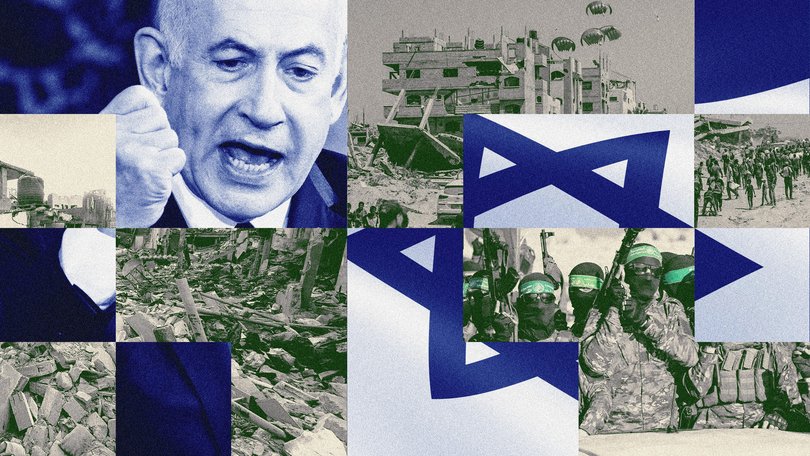Netanyahu vows to occupy Gaza as US touts ‘all or nothing’ hostage plan

Negotiations over a Gaza ceasefire appear to have reached an end - or at least a point of extreme brinkmanship - as Israeli Prime Minister Benjamin Netanyahu indicated he plans to expand military operations to occupy the entire Gaza Strip.
In a statement released by his office, Mr Netanyahu said he would convene his security cabinet this week to “direct the (Israel Defense Forces) how to achieve the three war objectives we have set … defeating the enemy, releasing our hostages and ensuring that Gaza will never again threaten Israel.”
An Israel official said that discussions with the Trump administration over the decision were ongoing. “There is a growing understanding that Hamas is not interested in a deal,” said the official, one of several people familiar with details of sensitive decision-making on Gaza who spoke on the condition of anonymity.
Sign up to The Nightly's newsletters.
Get the first look at the digital newspaper, curated daily stories and breaking headlines delivered to your inbox.
By continuing you agree to our Terms and Privacy Policy.The White House did not respond to questions on the Israeli plans, and declined to expand on comments Saturday by Steve Witkoff, President Donald Trump’s special envoy on the negotiations. Mr Witkoff told hostage families in Tel Aviv that his proposal for a temporary ceasefire and the return of about half of 20 living Israeli hostages still held by Hamas in Gaza “doesn’t work and we’ve tried everything.”
Mr Trump, Mr Witkoff said, “now believes that everybody should come home at once. No piecemeal deals.” He said the administration was formulating a new “all or nothing” plan. Both sides have rejected elements of the Witkoff proposal that has been on the table.
The State Department declined to comment.
Details of the administration’s new approach - or the extent to which it is related to Mr Netanyahu’s new military plans - remain unclear, according to diplomats and hostage families who have been briefed by US officials.
Officials in Qatar and Egypt, which, along with the United States have been mediating talks between Israel and Hamas almost since the nearly two-year-old conflict began, said they were not aware of any new US ceasefire deal.
While right-wing members of Mr Netanyahu’s government have long supported a complete takeover of Gaza, senior security officials have repeatedly insisted that Israel has achieved its military objectives of eliminating Hamas’s ability to govern Gaza or launch military offensives, according to Israeli media accounts.
The IDF says it already controls more than 75 percent of Gaza, a densely populated territory of 141 square miles. The United Nations has said that only 12 percent of Gaza is outside the Israeli militarized zone or areas not affected by IDF evacuation orders. The majority of Gaza’s 2.2 million people now live in tent encampments in the southern part of the enclave.
The IDF mostly has refrained from operating where Israeli intelligence indicates that hostages are being held. Hostage families and many Israeli security officials long have said that a negotiated agreement is the only way to bring the majority of the captives home.
“Netanyahu has decided to occupy the Gaza Strip, meaning that military operations will also take place in areas where hostages are being held,” said a person familiar with the Prime Minister’s decisions who spoke on the condition of anonymity because they were not authorised to speak with the news media.
Hostages freed from captivity have said in interviews with Israeli news media that their captors were under orders to kill them if they thought Israeli troops were approaching.
Einav Zangauker, whose son Matan is still held hostage in Gaza, wrote Monday on X: “667 days that the hostages are enduring a Holocaust in the tunnels, and instead of reaching a full agreement to end the war - a feasible one - Netanyahu is preparing an operation that will turn the living hostages into bodies and make the fallen disappear.”
Videos released by Hamas late last week of two hostages showed them as extremely emaciated. “You see your child dying before your eyes and you can’t do anything,” Ofir Braslavski, whose son Rom Braslavski was shown in one video, told the Associated Press.
Some family members who met with Mr Witkoff in Tel Aviv over the weekend said they thought the new plan he outlined in broad strokes was the best chance to lead to the release of all the hostages and an end to the war.
“This administration inherited this phased framework,” which led to two temporary ceasefires and the release of more than 200 hostages under the Biden administration, “and were convinced by the Israeli government that this was the best option for getting to a deal,” said Ruby Chen, the father of 19-year-old American Israeli Itay Chen, who was abducted by Hamas during its October 7, 2023, attack in southern Israel that sparked the war.
“But this administration has taken six months and realized it’s not a plan that they can execute, and they decided to shift and come up with a plan that has a better probability of success,” Mr Chen told The Washington Post.
The Israeli official said that “the Prime Minister is pushing for the release of the hostages while pursuing a military resolution, combined with the delivery of humanitarian aid to areas outside the combat zones and, to the extent possible, to areas not under Hamas control.”
Hamas’s release of the videos of skeletal hostages came as international outrage has grown over images of emaciated Gazan children amid what the United Nations has said are near-famine conditions.
Israel has restricted delivery of humanitarian assistance by international groups, instead supporting the Gaza Humanitarian Foundation, which runs four distribution sites in southern Gaza. Hundreds of Gazans have been killed as they pass close to IDF positions to reach the GHF sites, which are guarded by US security contractors.
A number of Arab and European countries, joined on Monday by Canada, have airdropped food into Gaza. Jordan, which has also sent aid by road, on Monday condemned what it called “the deliberate obstruction” of convoys by Israeli settlers as the trucks travel through the West Bank en route to Gaza.
“This is not the first time such violations have occurred,” Jordanian government spokesman Mohammad al-Momani said, according to the official Jordan News Agency.
Aside from the settler attacks, he said, Israel has placed severe restrictions on the number of trucks allowed to cross daily and has imposed convoluted approval processes, chaotic border inspections and newly added customs fees.
© 2025 , The Washington Post
